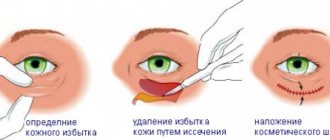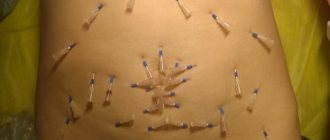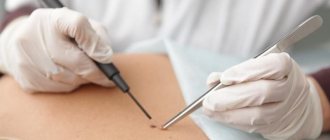- Preoperative period
- Preparing for surgery
- Choice of anesthesia
- Carrying out the operation
- Video of the operation
- Recovery period
- Contraindications
- Possible complications
Otoplasty is the surgical elimination of congenital or acquired (traumatic) ear defects. This operation is one of the most common in plastic surgery and allows you to adjust the size of the ears, their shape and location relative to the face. The surgical intervention affects the cartilaginous as well as soft tissues of the ears. Otoplasty is often recommended for children and adolescents, since protruding ears, asymmetry of the ears and other congenital defects can cause psychological disorders.
Types of otoplasty
- aesthetic (when the shape of the ears changes or they are given a more aesthetically correct appearance);
- reconstructive (restoration of a completely or partially absent auricle, both after congenital pathology and after injury);
- decorative otoplasty (a type of body modification, a newfangled trend in which “elven” ears with pointed ends are created).
Regarding decorative otoplasty, most plastic surgeons speak very coolly: from an aesthetic point of view, such an operation is not justified. Nevertheless, this operation has fans, and a number of clinics perform them. Doctors immediately warn those who want to have pointed ears: think about this in a calm mood, because you will get elven ears forever. This is a full-fledged surgical intervention - with anesthesia, a postoperative period, and you will have to take care of the stitches and give up your usual lifestyle for a while. Besides, if you suddenly want to return your ears to their previous shape, it will be impossible.
Reconstructive surgery of the outer ear corrects such defects as the already mentioned anotia - complete or partial absence of the ear due to injury or prenatal causes, various rudiments of the ear. This type of surgery often uses “donor” sites from other parts of the body, such as rib cartilage or cartilage from another ear. In our country, reconstructive operations have become widely developed and widespread. The main reason is that powerful military operations took place in our country, and people returning from the front often had combat injuries that also affected their ears.
There are more than 170 methods by which this deficiency can be corrected, and each doctor chooses a specific one for himself or practices using a complex of elements from different methods. It happens, for example, that the severity of protruding ears differs on the right and left, so the elements of the operation used to correct one ear and the other may also differ.
The traditional method of performing the operation involves the use of a scalpel. There is also laser otoplasty, in which incisions are made with a special laser. This process occurs much faster, and in addition, the likelihood of complications is reduced.
Note: plastic surgeons are most often approached by people who want to correct protruding ears - unilateral or bilateral. The cause of protruding ears is underdevelopment of the antihelix of the ear, as well as an increased angle between the ear and head.
Many patients have their own vision of the ideal ear shape. Yuri Mirzabekyan gives an example when a person consulted doctors twice:
“Previously, this patient had bilateral protruding ears, he was operated on and the result of eliminating the protruding ears was quite satisfactory to him. However, he did not like the size of his ears: he had so-called macrotia, large ears. I can’t say that the size of his ears went far beyond aesthetic standards or anthropometric data. But we met the patient halfway - we reduced his ears, and he was satisfied.”
Note: the shape and size of the auricles with protruding ears are within normal limits, only the auricles are located not exactly parallel to the temporal region, but more at a right angle. The ideal angle between the auricle and the head is 30 degrees.
Indications for use
The operation is indicated if:
- deformation of the auricle;
- protruding ears;
- damage to the lobe, cartilage, etc.;
- discrepancies in the size of the auricle relative to the head;
- congenital abnormalities of hearing organs;
- scars and cicatrices.
- with partial absence of the auricle.
The procedure is indicated for both children and adults with protruding ears and other ear deformities
Is it possible to correct the shape of the ear without surgery?
The formation of the ear occurs in the fetus already in the first trimester of pregnancy, then around the sixth month the internal folds and relief of the auricle develop. When a child is born, protruding ears are clearly visible, and already during this period it is possible to correct this defect with the help of swaddling and hats, without surgical intervention. If you manage to fix the ears that require changes, they will take the correct shape, because cartilage is quite pliable. Such correction is possible up to six months of age. After this, surgery is no longer possible.
Methods of ear correction using correction techniques
Modern plastic surgery has more than 200 different techniques for correcting the ears, but in practice only three methods are most often used.
According to Furnas
The technique is usually used to eliminate protruding ears. During the operation, part of the cartilage is dissected and removed, with further fixation of the auricle with an interrupted suture.
The D. Furnas method is most effective for children, adolescents and women with soft, pliable cartilage tissue.
According to Mustard
J. Mustarde's technique is also used to eliminate protruding ears. With its help, an anatomically normal antihelix is formed. Through the retroauricular approach, the cartilage is excised and the flat part of the ear is given a natural shape by applying several sutures.
According to Etenstrom-Stenstrom
The technique is similar to the Mustarde technique. The correct contour of the antihelix is formed by applying several notches on its outer surface. Sutures are then placed over the incisions to hold the cartilage in position.
Are there any beauty standards for perfect ears?
If we talk about aesthetic standards for the fit of the ears to the head, then it is traditionally believed that the distance between the skull and the edge of the ear should be about two centimeters, and the angle between the ear and the temporal part should be about 30 degrees. In this case, the ear should run parallel to the cheek. Of course, these are very approximate anthropometric data, and in practice, perhaps no one can boast of perfect ears. After all, a person is asymmetrical, and you will see noticeable differences even when comparing the left and right sides of the body, the same applies to the ears. As for their shape, the contours of the ear are so unique and individual that they can be compared to the pads of the fingers.
Preparation period
The patient undergoes examination by a number of specialists and consults with a therapist. If a patient has a number of chronic diseases, then he needs to talk with specialized specialists.
A number of mandatory measures to prepare for surgery:
- A person takes tests: a general blood and urine test; blood for biochemistry; analysis for AIDS, hepatitis, syphilis. In addition, he needs to get a cardiogram and undergo fluorography;
- Doctors, talking with the patient, find out whether he is prone to allergies to medications and whether there is a predisposition to scar formation. It is important to understand what operations they have undergone before;
- Before surgery, a person must properly prepare the body. To do this, he takes a course of vitamins and minerals for several weeks, “sits” on a diet rich in protein and vegetables;
- Within 14 days, the patient stops taking medications that negatively affect the blood clotting process. It is recommended to stop smoking and drinking alcohol for a while;
- Several hours before surgery, the patient should not drink or eat;
- Before surgery, it is necessary to rinse your hair and ears thoroughly.
The doctor also prepares for the operation, taking photographs of the ears from different angles, measuring their sizes, and calculating proportions.
How to prepare for otoplasty and are there any contraindications?
Otoplasty, of course, has contraindications.
“As a rule, these are general surgical contraindications or an allergy to a particular drug. There may be problems with oncology, problems with blood clotting. But this is being corrected, medications are being selected, there shouldn’t be any difficulties with this,” says Yuri Mirzabekyan.
Before the operation, you will need to undergo certain tests: they will depend on what kind of anesthesia the otoplasty will be performed under - general or local. The results of the tests are necessarily reviewed by the therapist, and only after that the date of the operation is set.
Cost in Moscow and St. Petersburg
| Type of transaction | St. Petersburg | Moscow |
| Correction of protruding ears | 30 000 | 35 000–45 000 |
| Deformation of the 1st degree of complexity | 15 000 | 20 000 |
| 2nd degree deformity | 20 000 | 25 000 |
| Plastic surgery of the auricle of the highest degree of complexity | 100 000–160 000 | 100 000–160 000 |
| Otoplasty of the lobe | 12 000 | 15,000 rubles |
| Removal of keloid scars | 3 000–6 000 | 3 000–5 000 |
Otoplasty is a practically safe procedure; its result depends entirely on choosing the right clinic and following the doctor’s recommendations. Such an operation will not only change your appearance for the better, but will also help you get rid of complexes, ridicule and ridicule. Otoplasty can also save an ear lost as a result of injury, as well as make a new ear if it is missing due to congenital pathologies.
How is otoplasty performed? How noticeable are the scars after surgery?
Otoplasty surgery is performed on the back of the ear in 99% of cases. The scar is hidden in a fold and is never visible, unless, of course, you stick out your ear too much.
“The operation itself is performed under local anesthesia, and if the patient is a child, general anesthesia can be performed. As a rule, the pain is minimal, the surgical techniques have been worked out, and the process of ear correction is carried out quickly. If it was local anesthesia, we give the patient the opportunity to look at himself in the mirror to immediately see the result,” the expert said.
In cases of local anesthesia, when the patient sees the process in the mirror, he may ask to “press” the ear or “add” something. Prominent ears are often corrected along with a change in the appearance of the lobes, because they can also be slightly protruding.
The duration of the operation is from half an hour to an hour, and it is tolerated quite easily. The only important condition: before surgery, it is important to take into account individual contraindications. If they exist, then the surgeon should be warned about this.
What is it and at what age can it be done?
Otoplasty is an aesthetic operation to eliminate ear defects, both congenital and resulting from injury.
Auricular plastic surgery is performed at any age . Surgery to correct the auricle is performed on both children and the elderly. If necessary, it is done even to children of the first year of life. However, it is pleasant to believe that the best age for this operation is between 5 and 7 years of age.
We invite you to watch a video about what otoplasty is:
Postoperative regimen after otoplasty
An important condition for quick recovery after otoplasty is a bandage that is applied to the ears immediately after surgery and worn for about two weeks, even after the stitches are removed.
“Despite the fact that the sutures are usually removed on the seventh or tenth day, I personally usually check the patient on the third day: just to see if everything is fine with him,” says Yuri Mirzabekyan.
On the first day, swelling and hematomas can be observed at the operation site. The bandages should not be tight because blood circulation may be impeded. Plus, compression brings pain. The patient is prescribed antibiotic therapy and anti-inflammatory therapy.
“After the stitches are removed, about two weeks later, we ask the patient to wear something like a T-shirt or an elastic bandage only at night. So that in your sleep you don’t accidentally break the adjusted ear when you turn your head. And, naturally, after the operation you need to take care of yourself like a crystal vase. Do not exercise to avoid injury,” our expert continued.
Reviews
Anastasia, 23 years old
“Hello, since childhood I was dissatisfied with my ears, I hid this flaw. When I firmly decided to undergo plastic surgery, I found out the opinion of my parents, and they supported me. We found the clinic thanks to my mother’s friends. Soon I went for a consultation and expressed my wishes to the doctor. He understood me instantly and told me what tests I needed to take. Afterwards the doctor gave recommendations. I strictly followed them and stayed at home for two weeks after the correction. There were no complications. Seven days later the stitches were removed, I was incredibly happy with the result. Of course, the ears were swollen and bluish, but it was only a month and everything was gone, and the stitches were only noticeable upon close inspection. It was six months ago, I have never regretted plastic surgery.”
16-09-2012
Darina, 32 years old
"Greetings to all. I also had otoplasty. I needed such a surgical intervention after an accident. A plastic surgeon who provides such services at reasonable prices was recommended to me at the hospital where I underwent rehabilitation. The operation was carried out six months after the accident. The bandage began to press on me the next morning after the correction due to swelling and I had to visit the doctor again. I was reassured that there were no deviations from the normal reaction. There were painful sensations, I took anesthetic drugs every day. I also didn't wash my hair for a week. The stitches have already been removed, my ears are slightly different in shape from each other, but this is not too noticeable. Although I don’t know what will happen next, the swelling hasn’t gone away yet...”
04-06-2013
Olga, 20 years old
“At the age of 20, I decided to have my ears corrected. I went into surgery with absolutely no emotion. It wasn’t scary, it felt like they just turned me off, I automatically came and they did it for me. I'm happy! And you know, I’m already a confident person, but after all this my confidence increased a couple of times. It can't even be put into words. And although I still almost always go around with loose clothes, the main thing is that something like this changes you not only outside, but also inside. It changes a lot. Now I’m learning how to tie high ponytails and buns, but I don’t know how to do them at all. I’ll write one thing: do this operation, don’t be afraid. This, of course, is not entirely easy, but just a week of torment and you will become a completely different person. It's worth it!!!! Believe me!
07-02-2013
Irina, 31 years old
“What a blessing to have normal ears now! A lifelong dream came true. The sinks were very protruding. She always walked around with her hair down. I was bullied a lot at school until I was in 9th grade. I didn’t want my ears to be pressed too close to my head, the doctor agreed with me. The operation itself was easy, I came out of anesthesia without any problems, in general, there were no terrible memories left. I’m very pleased with the result so far, even if they move a little more, it still looks beautiful. Then I’ll finally pierce my lobes. I really like them, at least one friend said that I had lost my individuality and became like everyone else. But I’d rather be like everyone else than Mickey Mouse.”
05-03-2014
Sofia, 17 years old
“I’m 17 years old, I’m finishing school this year. As a child, no one ever called me names; I don’t have any special complex about my ears. But soon school will end, more or less adult life will begin, you will have to enter a university, there are new people, new acquaintances, you must immediately declare yourself at first sight. So I decided to “stick on” my ears. I could live calmly without this, but more confidence and attractiveness to others will never hurt. I'm glad everything went so smoothly. Everything has healed, nothing bothers me, I like everything! And after all, nothing has passed, but it seems to me that my ears have always been like this, and there was no operation at all!!”
19-05-2015
More
Can there be complications after surgery?
Doctors include polychondritis as an unpleasant consequence of otoplasty, which is an inflammation that affects cartilage and connective tissue. Presumably, the nature of this inflammation is autoimmune. Possible wound suppuration and poor healing.
Surgeons must be careful to ensure that there are no bruises at the surgical site because this impairs healing. Much depends on how well the patient takes care of the sutures in the postoperative period. In general, with this intervention, general surgical complications are possible.
As for the aesthetic side of the issue, in practice, correction of the ears is not the simplest process, requiring a special sense of symmetry and the right approach, which, as a rule, only experienced plastic surgeons have.
Types of ear plastic surgery according to the method of intervention
There are several types of otoplasty. An ancient and fairly common method of correction is surgery performed with a scalpel.
More modern varieties include laser ear surgery - the incisions are made with a CO2 laser, which significantly reduces the traumatic nature of the procedure and reduces the risk of complications.
One cannot help but recall another type of correction - endoscopic otoplasty. The only drawback of the procedure is the high price - the intervention costs about 100 thousand rubles. Why so expensive? The fact is that the manipulation requires not only intricate work, but also the use of special equipment - an endoscope.
Can ears protrude again after otoplasty?
“I always like to say that surgery is a little more accurate than religion. It is impossible to predict 100% that everything will be the way we want. It often happens that nature intervenes in the process and one ear may, over time, protrude a little more than the other. Therefore, it happens that we make a slight correction,” summarizes Yuri Mirzabekyan.
An experienced doctor resorts to slight hypercorrection, with the aim that the ear will “move away” a little during the recovery period, already in the process of otoplasty. In this case, you shouldn’t squeeze too much, because some patients, for example, wear glasses. And a tightly pressed ear does not look very aesthetically pleasing.
To see the final result of the operation, you need to wait until the swelling goes away completely. Therefore, a full photo from the “Otoplasty: before and after” series can be taken only after a few months. Sometimes it may seem to the patient that the ear is not positioned correctly, but in fact the reason for this may be uneven convergence of the swelling. In such cases, surgeons recommend not to panic, because even if correction is necessary, it will be minimal.
Does it affect health?
Modern anesthesia for otoplasty does not harm health. Even for general pain relief, high-quality drugs of the latest generation are used, which no longer have the same effect as drugs of previous years. The use of these products is harmless to the body (including children). Coming out of an unconscious state is easy, without any consequences.
The local variety and sedation are also completely safe. In any case, the appropriate type of anesthesia will be discussed at the first consultation with the surgeon. The doctor will tell you about all the existing methods and which of them is appropriate to use in the current situation. The final choice remains with the anesthesiologist.









